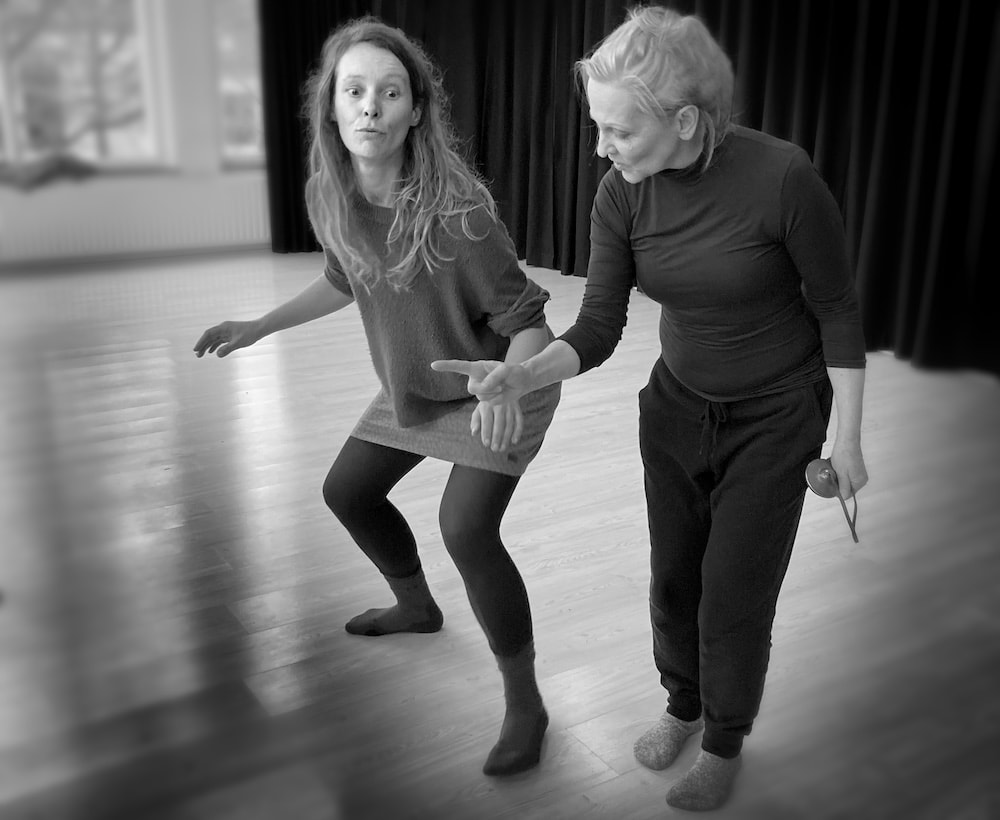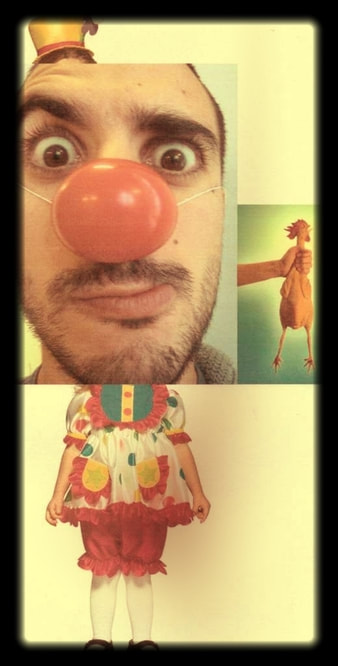 photo by Kirsten Lupke of ClownSpirit, Utrecht, enhanced by Robert Golden
photo by Kirsten Lupke of ClownSpirit, Utrecht, enhanced by Robert Golden 'Point fixe!', Philippe Gaulier would call out to a room full of theatre practitioners hungry to open their mind to the expertise of a European Master and to the art of clowning and play.
He would be asking for the moment to be held - or rather, sustained.
What is Fixed Point?
This post is about Fixed Point as I learned it from Gaulier and Monika Pagneux in a church hall just north of the Talgarth Road many years ago.
Fixed Point is the capturing of the body/being in a physical attitude in space and the sustaining of that enlivened shape for theatrical and comedic impact.
Exercise
The Fixed Point is arrived at by getting the player engaged in full-bodied physical movement and then calling ‘stop’ or ‘halt’ at a random moment. The player is instructed to avoid responding to the ‘stop’ instruction by completely dropping what they were doing and assuming a standing position. The idea is rather to arrest the movement of the player, like a single frame in a piece of film.
Even better than just running in the space, it’s good to get the players engaged in a game, so they are released into lively, engaged, strategic movement, suffused with the joy of play but also fleeting states of shifting micro emotions (perhaps: aspiration, hope, frustration, determination, victory …).
The command ‘Fixed Point!’ is intended to capture a physical attitude and a moment in time. It involves the whole body. Most rewardingly, the torso will be inflected - arms and legs are more functional and gestural, while an inflected torso conveys more emotional quality. I’ll write a blog post about that one day.
On first trial, the exercise may mostly be a challenge to equilibrium. There may also be a tendency to create a ‘freeze’; by clamping with the muscles in a generalised way; so that an idea of shape supplants nuance of expression. It’s important that, on the stop, the player develop the ability to sustain the way their body is configured in this moment – fully, exactly, specifically, with all the various inner dynamics intact.
To remedy any generalised ‘freezing’ that might happen, students can be invited to appreciate and sustain a living moment.
Move. Stop. Fixed Point.
Direct your attention to relish and ‘taste’ the energy in your body-being. Do a scan - you may have 65% tension in the muscle above your left knee, and 35% tension in your right wrist. Your chest should be informed by your position and so your breathing will be affected in a specific way. There should be a sense of possibility – of something just having happened and simultaneously, something just about to happen.
Troubleshoot
Avoid a tendency to sag. Fixed Point is a great way to train the stamina to sustain – to keep the dynamics alive and to avoid drooping in shape or energy. Fixed Point is not about perfunctorily holding a shape - it is about feeling and relishing the life in that captured moment.
Go again, stop again – new Fixed Point.
The student can hopefully notice how the body and being are engaged in a new, granularly specific configuration achieved by accident.
And if they don’t experience a different flavour in their next shape? This is part of the beauty and usefulness of the Fixed Point exercise – it shows up limitation caused by habitual tension or habitual body usage. A body in flow (agile and resourceful), together with a lively readiness to respond to the ‘stop’ command, can generate endless new postures/shapes – each with their own ‘character’ or ‘attitude’ or psychophysical flavour.
Keeping balance on a single leg may be a benefit of sustained practice, but it is not the immediate end aim of the exercise. If you are focused on keeping a leg off the floor, direct your attention to the torso. What is going on there? Is your chest inclined, pushed forward? rotated? Inclined? A combination of all these? If balance threatens a player who is caught on one leg, then instruct them to lightly place the foot down on the ground – but do that without changing the configuration of the torso, or its height off the floor. Here is another benefit of the exercise – the ability to arrange for ease and poise within the sustain, and to know that a softness in the hip and knee can be available while other muscles are engaged in other parts of the body. Chi Gung and Tai Chi are great training for soft, available wrists, elbows, ankles knees and hip joints.
Fixed Point and Clown
We love to see the clown-player arrested in an in-between moment, keenly engaged but also off-guard. It is the clown’s job to present the human condition unguarded. In the context of a clown class, Fixed Point can help the clown student to appear as if ‘caught out’ (think of the Grandmother’s Footsteps game).
Fixed Point training is a great way to appreciate the richness of a body/being invested vividly in a moment. And also to calibrate the distribution of tension throughout the body.
Also, with practice, it’s a great way to encourage awareness even while engaged in demanding movement. The clown audience relationship needs this kind of awareness.
Did they laugh? Are they seeing something in that specific moment that amuses them?
Fixed Point and laughter generation
Clown work can have a wide range of flavours including solitary, sad clown and poetic clown - but many audiences appreciate the ability of the clown to reliably generate laughter.
What a generous gift - to risk in that endeavour: to give the audience that release from tension. To take the audience on the life-emulating journey of tension, release; tension, release; tension, release, with the benefit of engaging an audience’s breath and gifting them with the energetic release of laughter. The license of laughter.
‘When you hear the audience laugh, chances are that just before the laugh you did something funny.’*
Stop. Fixed point. Check (clock), calibrate, connect. Then, working with the body-awareness that the FP can bring, you can replicate the physical and or vocal timbre of the moment before the laugh.
‘If the audience laughs, they should laugh again.’ – said Gaulier. (‘should’ meaning, if something made them laugh once, chances are that it will make them laugh again).
If you can re-deliver the moment, shape, rhythm and timber of the moment, there should be a laugh. If not, check (clock), calibrate, show your humanity (the emotion of the moment e.g. interest, confusion, inconvenience …) and re-connect (cast the net**).
Put another way - you hear the laugh - you stop at the exact moment (and in the exact shape – the audience is reading your shape and if you change it, it dissolves the previous moment, or comments on it – the audience has seen/experienced something in that moment – the clown’s eagerness, clumsiness, frustration, whatever expressed through their body, or the shape the clown and the angle of the prop they are using makes, perhaps. You stop, holding the FP and you can isolate the neck to clock the audience to a) notice b) connect c) maybe gain some information.
Why is it useful?
By training the ability to capture a Fixed Point, you avail yourself of an energetic attitude, a moment of what Monika Pagneaux called ‘life-full-ness’.
Working the Fixed Point has many benefits for the performer/actor: it trains integration of being and body; it grows charisma; it nourishes élan (French word for elastic, ready energy); it grows your ability to sense, capture and present a moment in performance.
We come to the theatre to see human expression. The human form moving with intention is compelling. Fixed Point is a beautiful thing. It is about capturing an energetic moment of body and being. It can add suspense to a moment of drama, or, in clown work, allow the audience to clearly see or relish a comedic moment.
Knowing how much there is in each second can inspire the performer to enjoy being infused by inner shifting dynamics, to develop a taste for radiating the different emotions or energy states of each successive moment.
Theatre is composed of moments of being, moments of movement, including both fleeting motion and suspended stillness. Audience's hearts can be moved by movement with its rhythm, phrasing, 'music' and timbre and spatial context constructed well with intentionality (dramaturgy) on stage.
As a student of laughter, I am fascinated by audience responses. At QEH in 2001, I saw Robert Lepage perform his solo show ‘The Far Side of the Moon’ I have been in many audiences where the audience laughs in unison at moments designed by the performer. Watching ‘TFSOTM’, I experienced an audience so engaged as to be moved to respond vocally in unison, in shared timbres, to moment after moment in the show: a short 'oh' of surprise; a nodding kind of 'ahhh!'; a gasp of surprise; a soft knowing laugh. Lepage’s performance (his script, stagecraft, physicality and dramaturgy) generated unison response after response after response – the entire audience innocently matching each other in both timing and timbre.
Kinestheology and Theatre
Studies on Kinestheology show how audiences can respond to the expressions of the bodies of the performers. Yves Marc of the iconic Corporeal Mime company Théâtre du Movement now performs a show where he invites the audience to explore their own state of being. Are they in a psychophysical state of readiness? Or in a condition of stasis: apartness, sluggishness, resisting of affect.
Over the years, in stealth and slowly, our hearts have been wounded and hardened by many factors. Might we ever risk to lose the enlivening communion of live theatre? Risk to lose our ability to offer ourselves up to the feelings in the stories and dances taking place before us, and in that availability, to have our beings re-enlivened, widened and deepened by exposure to a wide spectrum of feeling, to enlarge our empathy by witnessing and (via kinestheology) to feel and embody the predicaments of others, to lose our normal boundaries, in the specially dedicated, dark (or otherwise designed) space of the theatre.
* I say this teaching clown. I think it's my words but it maybe one of my teachers.
** I learned this from Alison Skilbeck and refer to it in the blog post on 1/31 2015.


 RSS Feed
RSS Feed
